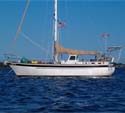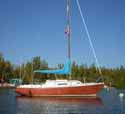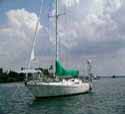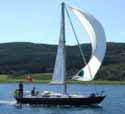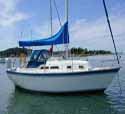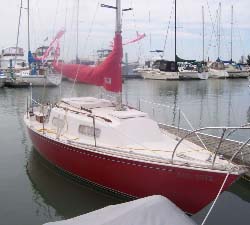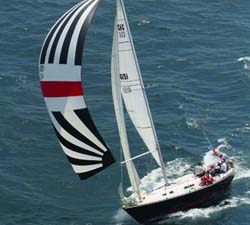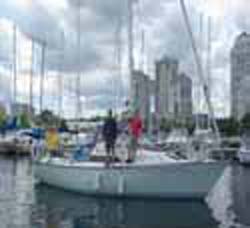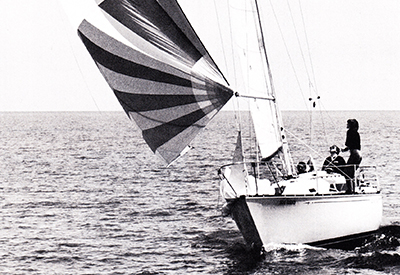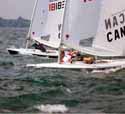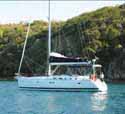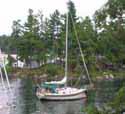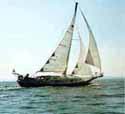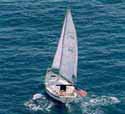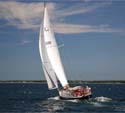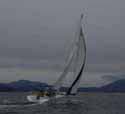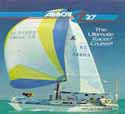October 29, 2009
Corbin 39
“I was looking for a boat that could take me safely and comfortably around the world,” writes Marius Corbin, the founder of Corbin les Bateaux Inc. in 1977. At the end of an extensive search for a serious long-distance cruiser, Corbin chose a design by Robert Dufour of Dufour Yacht Design in Montreal. Dufour’s Harmonie – the prototype of the Corbin 39 – had a canoe stern, a long, shallow fin keel with a vertical, skegg-supported rudder. Corbin and Dufour agreed to modify Harmonie by adding higher topsides and a flush deck to increase the boat’s interior volume. These modifications gave birth to the Corbin 39, and shortly after in 1979 Corbin les Bateaux pulled their first boat from its mould. Corbin elected to use encapsulated ballast in his hulls – a common boat-building method, but one that can make a hull vulnerable in a serious grounding as there is no external ballast to absorb the shock of a big bump. Corbin boasts, however, that he has added eight layers of fiberglass between the ballast and the hull so that his boat will not sink if the fiberglass keel is damaged.
October 29, 2009
Contessa 32
When British naval architect, David Sadler, drew the lines of this design in 1972, he gave the Contessa 32 a unique profile. At a time when cruising boats sported springy sheer lines, this racer/cruiser appears at least at first glance, to have a reverse sheer. In fact, the bow is higher than the stern, with the lowest part of the deck just forward of the cockpit. Other distinguishing features of the Contessa 32 are long overhangs, a narrow, tucked-up stern, low topsides and a narrow beam to length ratio. Below the waterline, Sadler has penned a moderate fin keel, with a skeg-supported rudder on a deep vee cross-section. In Britain, the Contessa was built at the Jeremy Rogers Boatyard, and was voted “Boat of the Show” at the 1973 Boat Show in London, England. Based on this initial success, the Rogers yard in Lymington went on to manufacture over 700 boats between 1973 and 1982.
October 29, 2009
Viking 28
“We wanted a good-looking, smart-sailing boat with berths for four,” said George Cuthbertson, the leader of the C&C team that designed the Viking 28. “But, we made a conscious decision not to distort the lines of this racer/cruiser in order to create headroom.” Considering the fact that Cuthbertson is 6 ft 4in., a 28-footer with headroom enough for his frame would have been very top-heavy. The Viking was the first of the C&C-designed Viking series built by Ontario Yachts in Oakville, Ontario. Later, this shop added the Viking 22, 33 and a modified 33 renamed as the Viking 34. Interestingly, in the early ’70s the Viking 28 made its way overseas when it was built by Anesty Yachts in England and renamed the Trapper 28…
October 29, 2009
Whitby 45
People keep coming up to Stranger II to ask about the boat,” said Nick de Munnik. “She’s the most beautiful boat in any anchorage,’ a real classic.” There are many elements that make a classic, including: designer, builder, owner and maintenance. Designer George Cuthbertson, one half of the founding pair of the design house Cuthbertson & Cassian Ltd. (later C&C Yachts), began his sailing career at Toronto’s Royal Canadian Yacht Club as a junior member ($50 for a summer of sailing). During his late teens and university years (Cuthbertson holds a degree in mechanical engineering from the University of Toronto), he was an official RORC race rule measurer for the RCYC, earning $25 per boat as a summer job…
October 28, 2009
Contour 30
A few years ago, Paul Countouris solved the age-old problem of space. Specifically, space at the marina. His Dragonfly 25, with its folding amas or outriggers (see CY, Killing On Design, Jan/Feb 1991), resolved one of the major problems of multihull owners at overcrowded marinas. Following the Dragonfly’s success (60 are now sailing North American waters), the designer, mould maker and yacht builder recently unveiled his newest speedster, the Contour 30. Countouris is manufacturing under the P.C. Mould Ltd. logo in an impressive 10,000-sq-ft facility in Erin, Ont. Now trading on his success with the Dragonfly 25, Countouris is building the Cole Beadon-designed Contour 30 for sailing enthusiasts who demand the same thrill of speed, coupled with a greater array of creature comforts below deck.
October 28, 2009
Contessa 26
The Contessa 26 entered production in England in 1966 by Jeremy Rogers in Lymington, with several hundred built. Moulds for the Contessa were shipped to Canada in 1969, with the first of the boats completed later that same year. J.J. Taylor and Sons Ltd. had been building boats on their site overlooking Toronto Harbour’s Western Gap since 1904. The Contessa would become the design to help this company change over from wood to fibreglass production. Taylor’s yard was later taken over by the National and Alexandra Yacht Clubs when the manufacturer moved to Rexdale, in Toronto’s dry-docked northwest quadrant. Other locally built boats from the 1960s, made of fibreglass but based on the lines of the Folkboat, are the Whitby 26 Folkboat and the Alberg 30. The family resemblance of moderate beam without pinched ends, pronounced sheer, long overhangs ñ especially at the bow – a long keel cut away at the forward end and a steeply raked rudder shaft attached to the keel, is obvious in all of these designs.
October 28, 2009
Columbia 8.7
An Australian America’s Cup designer, Alan Payne, designed the Columbia 8.7. It was one of a series of yachts in the new cruiser line of boats, deemed the “wide body super cruisers”, built by Columbia. The Columbia 8.7 has a turbulent production history. The first 8.7s rolled off the line in 1976, but in 1978 Columbia closed down because of labor problems. In 1979 Howard Hughes, from Hughes Boat Works, picked up all the molds and brought them to Centralia near London, ON. Hughes went into receivership in 1982. Aura Yachts then took over until 1986, at which point Hughes took the line back again. After this, Hughes built a few more 8.7s, until a fire destroyed his factory in Orangeville.
October 28, 2009
Cape Cod Frosty
For most sailors, the blustery onset of fall weather signals post-season sailing withdrawal, haul-out, and a generally gloomy winter outlook. For a growing group of hardy souls, however, this time of year brings new excitement. At six feet overall length and 36 pounds minimum weight, the Cape Cod Frosty is the world's smallest IYRU sanctioned one design class.Sailed in late fall, winter and early spring, this class is gaining popularity among sailors of all ages and abilities, who are ultimately united by one common desire – to extend the sailing season.
October 28, 2009
C&C SR 25
C&C International’s entry into the sport boat sweepstakes is the SR 25 – a slick, sleek 25-footer that expands this builders growing stable of single-purpose, strictly-racing fillies. Following a successful regatta debut at last years Key West Race Week, the SR 25 officially became the fastest monohull for its size built on Canadian shores. And so when C&C’s sales manager, Rob Maclachlan, offered CY his demo-boat to race in a local weekend regatta, our staff began to drool over their keyboards in anticipation. The event was Cornucopia, an annual 75-boat PHRF and one design regatta, hosted over the Labour Day weekend by the friendly folks at the Dalhousie Yacht Club in St. Catherines, Ontario. This would be the ideal venue to put our magazine staff and this tricked-out rocket to the test. Real life. Real sailing. Real review, so to speak. Now the only matter left to resolve was, “Who would steer?”
October 28, 2009
C&C 44
Seldom do boat reviewers have that good fortune—or the time—to experience a prolonged offshore test-sail over the course stretching from New York to the Virgin Islands. Indeed, sometimes the lack of such an opportunity may be a blessing. But in this case, my charge, a new C&C 44 named Some Nice (a Maritime expression), owned by Greogory Bohaker of Toronto, performed well, giving us a fast, carefree passage.In an area of the North Atlantic that offers diverse conditions at the best of times, particularly during the spring season, our route (turn right off Gibb’s Hill Light, Bermuda) was a challenging test of our yacht’s potential. Some Nice withstood the test. Except for the intervals of rail-side gyrations, my intrepid crew including the owner, also survived.I have sailed on most of C&C’s recent production yachts on the Great Lakes and offshore.
October 28, 2009
C&C 35 Mks I and II
It was a blustery October afternoon when I went for a sail with Peter and Caroline Ross and their daughter Tracy, from the Oakville Yacht Squadron. We were sailing on Fritha, hull no. 245, built in 1974. I took over the helm as we motored out of the channel, while Peter and Tracy hoisted the full mainsail. Ross explained how it had been shortened by 10 inches so the boom could be raised to accommodate their large dodger. They rolled out the genoa, telling me how it was cut higher than the usual #2 to allow for better visibility.
October 28, 2009
C&C 33
When I first met Bruce Massey, the owner of the C&C 33 I was to test sail, he had just won PHRF Division I at the C&C Owners Regatta in Oakville, Ontario, in mid-July, finishing ahead of C&C 34s and 35s on elapsed time. He was one happy guy! I imagine most of us would have second thoughts about buying a design before it was fully established in our area, even from a proven design team such as C&C. This early performance convinced him that he had made an excellent choice and that the design was destined to be an outstanding one. The first boat was launched in August 1984 and by July this year hull 97 was being built.
October 28, 2009
C&C 30 Mark I
With over 800 built, the C&C 30 Mk1 is, arguably, one of Canada’s most successful racer/cruisers. Production began in 1973 and ceased in 1985 — a 12-year period that represents the longest production run of any single design version in the history of C&C Yachts. Although more 27s were built, in excess of 1,000, over a similar 12-year production period, with four distinct design phases, the 27 underwent comparatively continual change in relation to the 30, having only the one design version.
October 28, 2009
C&C 29
The New C&C 29, White Hawk, is George Doing’s first sailboat. Following 16 years of boating in small powerboats, a Northern 29, and most recently in the competitive Toronto Etchells 22 fleet, he decided it was time to launch his own campaign in the Lake Ontario MORC fleet. George wanted a club racer he could sail with his two boys, aged 9 and 11, and still cruise with the family. Both he and his wife, Katheryne, wanted more luxury than they had experienced during early years camping together. Having rejected several used boats (on the basis that if you’re going to buy a used boat, it should be a bargain and there are no bargains around), they settled on the successor to the C&C 27: the new 29, which went into production last November.
October 26, 2009
Byte
I like sailing little boats. Their spirited performance lets them respond instantly to a puff or to bounce across the waves delivering quick precise feedback for the sailor. There is no sluggishness, no inertia from a heavy lead keel and no crew to buy lunch for. Small boat racing is returning to my local club in Midland, Ont., and a good part of the reason is the simplicity. Preparing the boat for a race is only a matter of minutes. The leader in this field for a long time has been the Laser, a 14-foot singlehanded daggerboard boat designed by Canadian Bruce Kirby. Manufacturing the craft has had its ups and downs but the more than 100,000 boats built are surely a milestone of success.
October 26, 2009
Beneteau 523
It must be a yacht designer’s nightmare to be commissioned to create a replacement for perhaps the most successful 50 footer ever manufactured, the Bruce Farr designed Beneteau 50, of which over 400 hulls were produced between 1996-2004. The French team at Groupe Finot took the challenge to heart having had several other designs selling well on the French builders line including the 323, 423 and 473. On a recent trip to France, we were lucky enough to not only sail the new 523 but we also had a terrific tour of two of the Beneteau production facilities there.
October 26, 2009
Bayfield 36
The Bayfield 36 favours old-time and modern conveniences which give this popular cruiser the well-earned title of a contemporary classic. Although Bayfield Boat Yard of Clinton, Ontario, builds sail boats that are traditional-looking, there is nothing outdated about the marketing finesse of this firm…
October 26, 2009
Bayfield 32
In the early 1970s, most boat builders were developing fin-keeled racer/cruiser lines of production sailboats. Bayfield Boat Yard, in southeastern Lake Huron, bucked this trend by producing a line of long-keeled cruising boats…
October 26, 2009
Bayfield 29
The Bayfield 29 is a cruising yacht with traditional styling and design features. Hull shape and sail plan are oriented toward safe and stable handling in all conditions, rather than high performance…
October 26, 2009
Aloha 8.5
The Aloha 8.5, a sound, comfortable cruiser, has a traditional air. It packs a lot of interior space into its 28 feet without compromising its long, pleasing lines and gentle curves. The $51,800 price tag (March 1985) is even more competitive than it seems because an extensive list of extra features is included as standard equipment — a steel storage cradle, antifouling, three sails with mainsail cover and a compass, to name a few. Created in 1972 by the Brewer and Wallstrom design office, the Aloha 8.5 has been in production for 13 years and more than 200 have been sold. It was designed to provide cruising comfort and stability along with solid sailing performance. Maximizing racing performance under arbitrary rating formulae was not part of the designer’s mandate.
October 26, 2009
Alberg 37
June 8…”A nice morning, but a brassy glare gets us worried. By 1130 we have rain and the wind picks up. With a third reef in the main and the genoa rolled back to a number three, we are making seven to eight knots. The boat is awash with breaking seas and spray keeps flying over the boat. My gourmet meal suffers as cutting and cooking have become a lethal exercise.”
October 18, 2009
Bavaria 50 Cruiser
Greg Nicoll, our affable Vice President was once quoted “it’s hard being us” and on the trip to British Columbia earlier this year, he was right. Thanks to our great friends at Yacht Sales West we got to test the new Bavaria Cruiser. Designed to replace the 49, this new boat will not disappoint in function, feel and it’s great (what I call) rugged looks. This boat was built to sail and sail hard. Comfortable, great visibility and the dual wheel steering all add up to a wonderful boat made for those who want to cruise in style. From the moment I took the wheel, the boat was light on the helm and easy to steer. It reacted well to powering up; it tacked effortlessly, though we were a bit slow bringing the large genoa in,; clearly we needed a bit of practice. The boat moved well in the light to medium conditions on our test day reaching 5 knots easily in winds that may have topped 7 knots true.
October 18, 2009
Alberg 30
With more than 710 built over two decades, the Alberg 30 is a Canadian success story with American and Swedish connections. In 1962, six folkboat racers from Toronto’s National Yacht Club decided that they wanted a bigger boat. They asked Kurt Hansen of Whitby Boat Works to find a suitable design and build it for them. The late Carl Alberg (1900-1986) – Swedish by birth, but a U.S. immigrant – was approached in January 1963. Neither the well-known designer nor the Canadian builder wasted much time producing the finished product. The first Alberg was launched July 7, that same year.
October 18, 2009
Abbott 33
That’s the lilting refrain from old Abbott and Costello shows. It’s also how some Abbott sailors hail their competitors on the start line. Abbott sailors are a fun-loving fraternity. They enjoy friendly rivalry and their familiar cheer is their way of not taking themselves too seriously. Abbott Boats of Sarnia, Ontario produced four sizes of Abbotts: the Abbott 28 in ’64, the Abbott 22 in the early ’70s, the Abbott 33 by 1980, and the Abbott 27. There are also plans for an Abbott 36, although none have been built to date. In the ’60s, Bill Abbott built wooden Folkboats and the Olympic class Dragon before he built his namesake. Now, he also builds the Soling.
October 18, 2009
Abbott 27
When I review a new boat from an established builder or designer, I try to compare it with other boats they have produced. With Abbott, the boat I know best is the Abbott 33, a fast, sleek racing boat that you can still cruise on. I learned something interesting about the philosophy of the new Abbott 27 when I compared it with the 33. Although it is six feet shorter, their weights’ are the same. Bill Abbott Sr., the designer (and builder), and his son Bill Jr., have kept their small shop purring along building international class Solings and Wayfarers. The Abbott 22, 33 and 36 are interspersed in smaller numbers but nevertheless make a significant contribution to their success.

